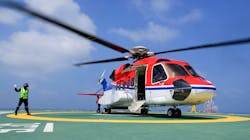According to a June 2021 Fortune Business Insights report, the global helicopter maintenance, repair and overhaul (MRO) services market size was worth $7.21 billion in 2020. Despite the challenges thrown at the sector during the pandemic, it is still projected to grow from $7.48 billion in 2021 to $10.23 billion in 2028, a compound annual growth rate of 4.57%. With increased short-distance air travel and rapid urbanization driving demand for helicopter services across the globe, two technical advisors at Jet Support Services, Inc. (JSSI), discuss the market and MRO ecosystem from both sides of the pond.
UK-based Ty Corley, helicopter technical advisor at JSSI and technical chairman of the British Helicopter Association (BHA), and Kevin Mawhinney, helicopter technical advisor at JSSI, based in San Francisco, highlight some of the current industry trends and challenges for operators.
What Does the Helicopter Maintenance Market Look Like for 2022?
Corley: As the pandemic continues to subside and restrictions are slowly being lifted, the maintenance market is picking up. I see demand for VIP and emergency medical services (EMS) increasing, with AW109s for VIP services and the five-bladed H145 and AW169 helicopters for EMS leading the way.
One key indicator that the market is recovering is that there are more job opportunities being advertised for engineers in the aviation and helicopter market. Also, an increase in aircraft coming out of storage to support the upsurge in oil, gas and offshore renewables over the coming months will result in further demand for maintenance teams.
Mawhinney: The upward trend in flight activity in North America and across the world will drive helicopters into maintenance facilities to overhaul dynamic components, repair instruments, or refinish rotor blades. Combined with an increase in aftermarket sales, I would expect MROs to be busy this year with pre-purchase inspections and customizations for new owners.
How Healthy is the MRO Ecosystem?
Mawhinney: A backlog of work would usually be a good problem for MRO shops to have. However, for those short on mechanics due to the pandemic, retirements, or the lack of new mechanics coming into the industry, it’s becoming a juggling act to keep the work on schedule. This problem isn’t going away anytime soon, particularly as the maintenance workforce is getting older. Without an immediate intervention, we are heading toward a critical mass.
Another piece of the puzzle for MROs is inventory management. Not just the capital required to have parts on the shelf but buying the right parts. The overall cost of parts has also increased and shops are forced to pass this on to the client, which can be tough to explain when it exceeds the original budget.
What used to be a closed ecosystem between an MRO and the OEM has expanded to include third-party options to support maintenance operations. This encompasses not only securing parts but utilizing outside maintenance sources to assist with specialized work. Many of the MROs that hold specialized training and capabilities are traveling to clients to perform these services.
Corley: Across Europe the MRO ecosystem is healthy, despite more supply chain pressures than normal due to the pandemic and Brexit increasing workloads and prices of parts and services. However, due to the ongoing impact of COVID restrictions and the fallout from Brexit, there is a shortage of qualified engineers, and UK licensed engineers are currently not being authorized by EASA to work on EASA registered aircraft, despite the UK allowing EASA licensed engineers to work on UK registered aircraft. Thankfully, as COVID isolation rules are eased in the UK we are seeing staff being able to return to work quicker, which is reducing the pressure.
What Lessons Have Been Learnt from 2021?
Mawhinney: The main lesson learned from 2021 is the need for flexibility. The past two years have required us all to continually make new plans based on the changing environment. The supply chain has been stretched thin, and as a result, it’s not simply a case of shipping an aircraft part across the world anymore. MROs have become used to having to deal with an engine seal stuck with a courier company due to weather, COVID or other delays. Historically, a priority delivery would arrive first thing in the morning to make a flight that day but that’s no longer a guarantee.
Corley: For me, the main lesson learned is how resilient the helicopter market is, particularly compared to commercial fixed-wing operations. This is largely due to the many ways in which helicopters can be used. EMS helicopters and parapublic activity were both relatively unaffected during the main part of the pandemic. Also, the VIP charter side of the market saw a resurgence of utilization during 2021; this can partly be attributed to the return of popular public events in the UK, such as Royal Ascot and the Grand Prix at Silverstone, which are both significant events for the helicopter industry.
What Trends or Pitfalls Should Operators Look Out for in 2022?
Mawhinney: This year, I’d expect to see an increased use of aircraft maintenance data. We’ve come to a point in the industry where instead of operating on tribal knowledge and overnight delivery, we have an opportunity to tap into years of historical information. A helicopter operator or an MRO can schedule and forecast inventory requirements and upcoming scheduled maintenance events based on facts and not educated guesses. We’ve made the jump from paper format technical manuals to online versions and from whiteboards to computerized maintenance tracking systems. So, it’s not a huge leap to integrate this information into something we can use.
The other trend I can see is the use of drones for some historically helicopter-dependent operations. While I don’t think this is going to happen in the next couple of years, it’s something we need to be aware of.
Corley: I expect there to be longer lead times on new helicopter orders due to increased demand. This may be offset by bringing more aircraft out of storage to support the offshore market. There will likely also be additional growth in the EMS, search and rescue, offshore renewables and VIP markets, with the AW109, 169 and H145 D3 proving popular. Although shortages of qualified staff may affect growth initially here in the UK, there is the potential for staffing to be rectified in the longer-term, as companies begin to invest in training younger people by way of apprentice schemes and licensing.
Also, as MROs look to navigate the challenges of Brexit transition issues and inflationary pressures, I concur with Kevin that the use of maintenance data will become much more commonplace, with MROs streamlining activities by investing in maintenance tracking software such as Traxxall and SierraTrax.
There are plenty of challenges and opportunities facing MROs as the post-pandemic landscape is navigated. However, with the popularity of helicopter usage on the rise, the only way is up



